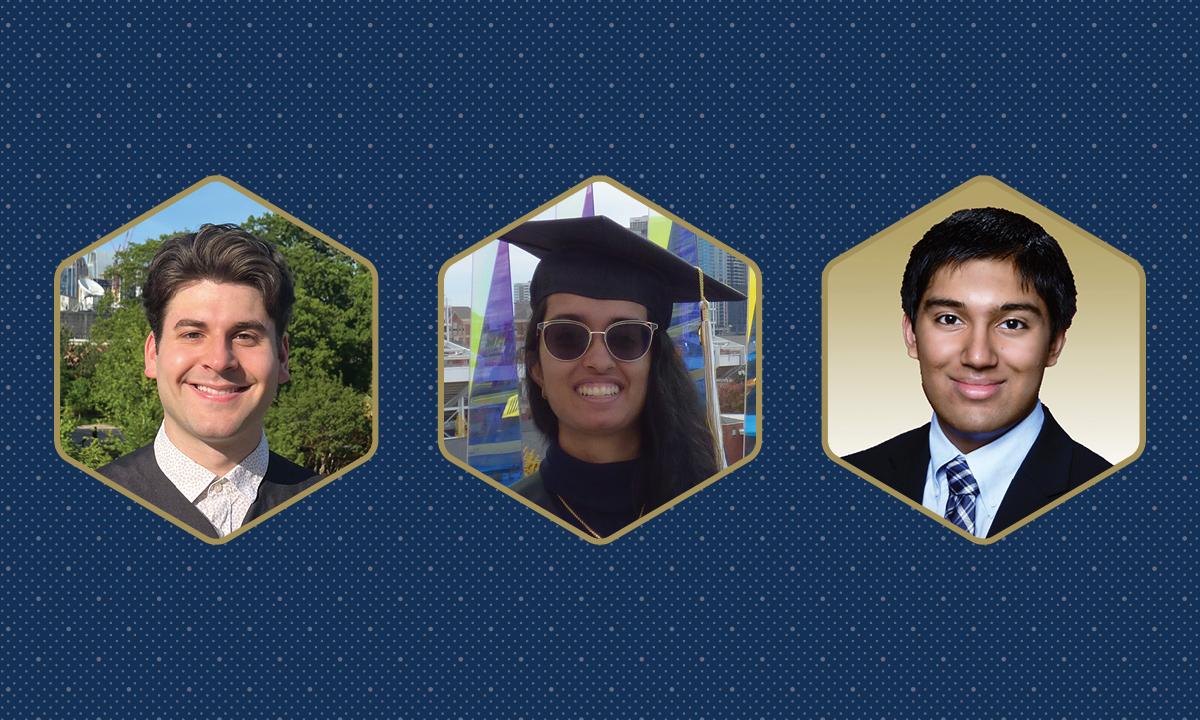As fellows, Alexander Chipps, Satvik Kumar, and Preethi Mysore are considered future leaders in research and teaching.

Alexander Chipps, Preethi Mysore, and Satvik Kumar
Alexander Chipps was only half awake when he discovered that he was the recipient of a National Science Foundation (NSF) Graduate Research Fellowship. On an otherwise-ordinary morning, he woke up, blearily picked up his phone, and checked his email, only to find that he had received the fellowship.
“I was shocked, because the fellowship is so competitive,” said Chipps, who graduated from the George W. Woodruff School of Mechanical Engineering with his undergraduate degree in May and will be starting a master’s degree in aerospace engineering in the fall. “My hopes were low because I was coming off a string of grad school rejections. That email made me feel like all my hard work had finally paid off.”
The NSF graduate fellowships are among the most prominent research support of their kind, and the oldest. Since its creation in 1952, recipients of the fellowship have gone on to become Nobel laureates, members of the National Academies, and founders, experts, and innovators in their fields. The fellowship provides full funding for three years of graduate research in science and engineering; its recipients are expected to make significant contributions to research, teaching, and innovation.
Only 16% of applicants received fellowships in 2023, including 38 students from Georgia Tech. Three are students in the Daniel Guggenheim School of Aerospace Engineering (AE School): Chipps, Preethi Mysore, and Satvik Kumar. Lizzie Kimmel received an honorable mention.
While pursuing his bachelor’s degree, Chipps worked with Christopher Carr in the Planetary Exploration Lab (PXL) in the AE School, and describing his research as “hunting aliens.” More formally, he researched devices for the detection of microbial life beyond Earth; one of his projects was deployed on the International Space Station in November 2022. His NSF research proposal focused on stability analysis for high-altitude balloons, which could help detect life in the cloud layer on Venus. Chipps will be returning to the PXL for graduate school.
Satvik Kumar recently graduated from the AE School with his bachelor’s degree. Like Chipps, he had low expectations for his fellowship application. Applying as an undergraduate, he assumed he would have to wait until he was in graduate school to have a shot. But during his time at Tech, Kumar co-authored papers in the Aerospace Systems Design Lab and the Aerial Robotics and Experimental Autonomy Lab, interned at NASA, and co-chaired Tech’s chapter of the American Institute of Aeronautics and Astronautics.
“It’s a great honor to be included with this group of fellows,” Kumar said, “I have to credit the diversity of research and internship opportunities I had at Georgia Tech and my research mentors, who trusted me enough to give me ownership of projects that I really enjoyed.”
Kumar has been fascinated with aircraft for as long as can remember and decided he wanted to be an aerospace engineer in fifth grade. His love for aviation kept him going during his undergraduate years and led him to research on unmanned aerial vehicles (UAVs). He said the NSF fellowship gives him the freedom and flexibility to continue exploring his passion at CalTech, where he will be pursuing his Ph.D. in aerospace engineering with a focus on robotics and formation flying in space.
“The NSF fellowship gives me the ability to take projects the direction I want to, without worrying about where the funding comes from or if my sponsors will approve,” Kumar said.
For Mysore, a first-year Ph.D. student in the AE School, receiving the fellowship felt like a validation of her research in the High Performance Computing lab.
“It can be easy to get overwhelmed by the process of filling out fellowship applications,” she said. “Oftentimes it feels like you're supposed to know exactly what you want to do, even though you're still an undergraduate student when applying. Getting this fellowship helps me feel more at ease with the direction I'm going and reinvigorated my interest in my work.”
Mysore works in the field of computational fluid dynamics and researches turbulence at hypersonic speeds with the goal of designing more efficient aerospace vehicles. She said the NSF funding gives her the ability to focus on purely her own research; eventually, she hopes to help move the field toward high-speed vehicles for civilian travel.
Mysore said she’s learned it’s okay to explore and not have all the answers.
“Put yourself out there. It's okay to not know everything; even the professors that have models or theories named after them don't know everything. But trying new things and pushing your boundaries is the best way to figure out what you like and what you don't,” Mysore said. “Even if you don't figure out exactly what you want to do by the time you are applying for fellowships or graduate school, you'll learn a bit more about yourself in the process.”
(text and background only visible when logged in)